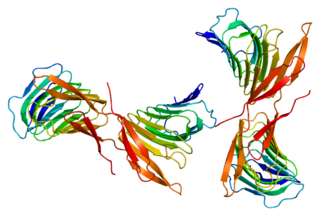Adenylyl cyclase type 4 is an enzyme that in humans is encoded by the ADCY4 gene. [5] [6]
Adenylyl cyclase type 4 is an enzyme that in humans is encoded by the ADCY4 gene. [5] [6]
This gene encodes a member of the family of adenylyl cyclases, which are membrane-associated enzymes that catalyze the formation of the secondary messenger cyclic adenosine monophosphate (cAMP). Mouse studies show that adenylyl cyclase 4, along with adenylyl cyclases 2 and 3, is expressed in olfactory cilia, suggesting that several different adenylyl cyclases may couple to olfactory receptors and that there may be multiple receptor-mediated mechanisms for the generation of cAMP signals. [6]

Adenylyl cyclase is an enzyme with key regulatory roles in essentially all cells. It is the most polyphyletic known enzyme: six distinct classes have been described, all catalyzing the same reaction but representing unrelated gene families with no known sequence or structural homology. The best known class of adenylyl cyclases is class III or AC-III. AC-III occurs widely in eukaryotes and has important roles in many human tissues.

Pituitary adenylate cyclase-activating polypeptide also known as PACAP is a protein that in humans is encoded by the ADCYAP1 gene. PACAP is similar to vasoactive intestinal peptide. One of its effects is to stimulate enterochromaffin-like cells. It binds to vasoactive intestinal peptide receptor and to the PACAP receptor.

Pituitary adenylate cyclase-activating polypeptide type I receptor also known as PAC1, is a protein that in humans is encoded by the ADCYAP1R1 gene. This receptor binds pituitary adenylate cyclase activating peptide.

P2Y purinoceptor 11 is a protein that in humans is encoded by the P2RY11 gene.i

Vasoactive intestinal peptide receptor 2 also known as VPAC2, is a G-protein coupled receptor that in humans is encoded by the VIPR2 gene.

Adenylyl cyclase type 6 is an enzyme that in humans is encoded by the ADCY6 gene.

cAMP-dependent protein kinase catalytic subunit beta is an enzyme that in humans is encoded by the PRKACB gene.

Adenylyl cyclase type 3 is an enzyme that in humans is encoded by the ADCY3 gene.

Visinin-like protein 1 is a protein that in humans is encoded by the VSNL1 gene.

Adenylyl cyclase type 5 is an enzyme that in humans is encoded by the ADCY5 gene.

Adenylyl cyclase type 1 is an enzyme that in humans is encoded by the ADCY1 gene.

cAMP-dependent protein kinase catalytic subunit gamma is an enzyme that in humans is encoded by the PRKACG gene.

Adenylyl cyclase-associated protein 1 is an enzyme that in humans is encoded by the CAP1 gene.

Adenylyl cyclase type 2 is an enzyme typically expressed in the brain of humans, that is encoded by the ADCY2 gene. It belongs to the adenylyl cyclase class-3 or guanylyl cyclase family because it contains two guanylate cyclase domains. ADCY2 is one of ten different mammalian isoforms of adenylyl cyclases. ADCY2 can be found on chromosome 5 and the "MIR2113-POU3F2" region of chromosome 6, with a length of 1091 amino-acids. An essential cofactor for ADCY2 is magnesium; two ions bind per subunit.

Adenylyl cyclase type 7 is an enzyme that in humans is encoded by the ADCY7 gene.

Adenylyl cyclase type 9 is an enzyme that in humans is encoded by the ADCY9 gene.

Adenylyl cyclase type 8 is an enzyme that in humans is encoded by the ADCY8 gene.

Guanine nucleotide-binding protein G(olf) subunit alpha is a protein that in humans is encoded by the GNAL gene. Its main product is the heterotrimeric G-protein alpha subunit Golf-α, a member of the Gs alpha subunit family that is a key component of G protein-coupled receptor-regulated adenylyl cyclase signal transduction pathways in the olfactory system and the striatum in the brain. It also mediated D1 receptor signalling in the striatum and is hence involved in motor control.

Inositol 1,4,5-trisphosphate receptor, type 2, also known as ITPR2, is a protein which in humans is encoded by the ITPR2 gene. The protein encoded by this gene is both a receptor for inositol triphosphate and a calcium channel.

Adenylyl cyclase 10 also known as ADCY10 is an enzyme that, in humans, is encoded by the ADCY10 gene.